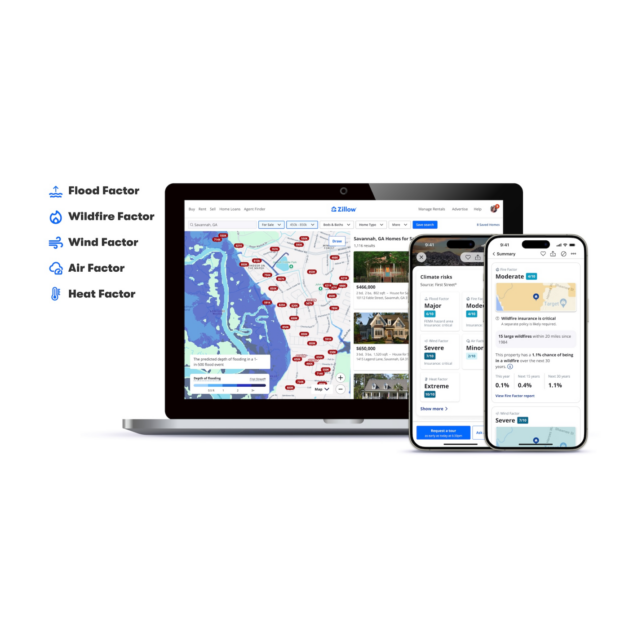For-sale listings on Zillow will now feature detailed climate risk information for five key categories — flood, wildfire, wind, heat and air quality — along with insurance recommendations, according to the online real estate company.
The climate risk data, provided by climate risk financial modeler First Street, will be available on for-sale property listings across the U.S. directly on listing pages, complete with risk scores, interactive maps and insurance requirements.
More than 80 percent of buyers now consider climate risks when purchasing a home, according to online real estate firm.
“Climate risks are now a critical factor in home-buying decisions,” said Skylar Olsen, chief economist at Zillow. “Healthy markets are ones where buyers and sellers have access to all relevant data for their decisions. As concerns about flooding, extreme temperatures and wildfires grow — and what that might mean for future insurance costs — this tool also helps agents inform their clients in discussing climate risk, insurance and long-term affordability.”
Climate risk information will be available on the Zillow app for iOS and on the Zillow website by the end of the year, with Android availability expected early next year.
When using the search map view, home shoppers can explore climate risk data through an interactive map highlighting the five key risk categories. Each risk is color-coded and has its own color scale. Labels give more context to climate data and link to First Street’s property-specific climate risk reports for full insights.
The information not only shows how these risks might affect the home now and in the future, but also provides information on wind, fire and flood insurance requirements.
Nationwide, more new listings came with major climate risk, compared to homes listed for sale five years ago, according to a analysis conducted in August. That trend holds true for all five of the climate risk categories Zillow analyzed. Across all new listings in August, 16.7 percent were at major risk of wildfire, while 12.8 percent came with a major risk of flooding.
First Street’s analysis of the impact of Hurricane Debby found 78 percent of properties flooded by that hurricane were outside FEMA flood zones, and consequently located where flood insurance isn’t mandatory. With this new option, 85 percent of these properties would have received an insurance recommendation on Zillow, highlighting how climate risk data can guide users in assessing insurance needs and making informed decisions about their future homes.
“At First Street we are on a mission to connect climate change to financial risk,” said Matthew Eby, founder and CEO of First Street. “Partnering with Zillow helps us achieve that mission by providing the millions of everyday users on the Zillow platforms with the same property-specific climate risk data that is used by top banks, agencies and investors.”





















 U.S. E&S Outlook No Longer Positive: AM Best
U.S. E&S Outlook No Longer Positive: AM Best  Bankers Readying U.S. IPOs at ‘Overwhelming’ Pace Ahead of 2026
Bankers Readying U.S. IPOs at ‘Overwhelming’ Pace Ahead of 2026  Unpacking a Consumer Intervenor’s Novel Idea
Unpacking a Consumer Intervenor’s Novel Idea  What to Expect in 2026: U.S. P/C Results More Like 2024
What to Expect in 2026: U.S. P/C Results More Like 2024 




